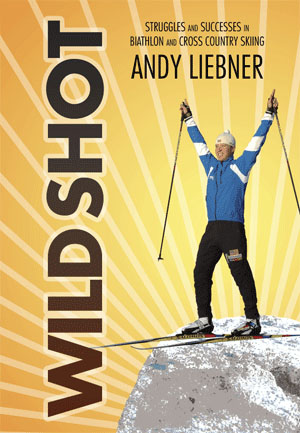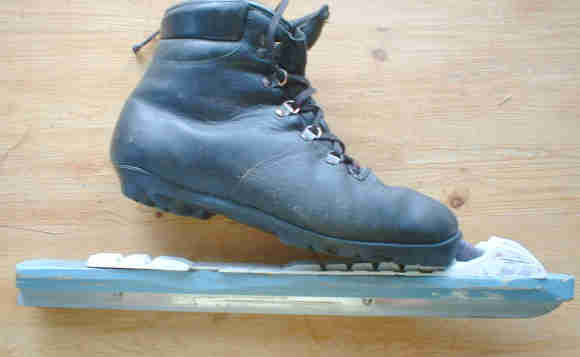You don’t have to speed…it’s just nice to be able to go for a cruise
Part One–Starting out
There should be a secondhand shop in your area with skates. If you can find the ubiquitous place that does exchanging for local figure and hockey skaters as they get older, etc., you’ll probably also find a nice speeder set real cheap. I’ve had a couple $20 pairs of dandies. But I recently finally hit the jackpot and found at the local Skate Exchange a pair of superlong extranice new skates for $50 (were probably $250).
Buy a pair and sharpen them. Grind the blades flat. You know they’re ready when there’s an even burr along the edgesãgently knock this off with a stone run along the side of the blade.
Go find some ice. You can gauge black ice thickness by studying the fractures in the see-through surface. What you see is what you get. Which is half the fun of this new world. Sometimes you can see the bottom of an entire lake as you zoom along.
Sure the boots are wimpy. Don’t let that, or your previous skating history, fool you. Get skates that fit snug. Lace ’em up snug. And head out. Fall down. Cave in after ten minutes. That’s fine. Your ankles need breaking in. After you can’t support yourself any more, go to the shore, remove skates and put on Sorel winter boots and walk around. In ten minutes, put the skates on again tighten the laces even more (the boots stretch) and give it another whirl. Three tries and you’ll be done the first time. Next day do it again. Each time you skate, provided you don’t let too many days lapse between episodes, you’ll be able to stay out longer. Two weeks of this and you’ll be able to skate 2 1/2 hours straight. This is whether your ankles are supposedly wimpy or not. Then, forever more, each season you start skating it’ll take only a couple sessions to be up to snuff, ankle-wise.
Skating on lakes and rivers is just rocking and rolling along. On downwind stretches in a good breeze if there are ice-boats on a lake you can find yourself zooming along faster than they are. Get your strokes way long and slow and all you feel is an incredible, subtle rumbling under your feet. Whoosh!
Black ice skating is a great way to party. Nobody does this sort of thing anymore. You get funny looks, so it’s that much more of a hit if you can get people to trust you and show up. It’s spontaneous and inate fun, day or night. Build a bon-fire. Bring blankets, boots, hot booze, food, chocolate, flashlights. See shooting stars and meteor showers, even in the big city–if your lake is big enough.
On any occasion there’s also plenty to do whenever you have to take a break to rest. Freak out about how far you can glide a rockãseems like a quarter mile. Listen to the reverbs of big rocks boinging on the surface. Chase fish and muskrats you see along the bottom. Study the lake. It’ll be just you and the weather and the vee’s of geese flying overhead.
Part Two—Catching the vibe
Find a coach is the best way. But the basic steps are easy enough to learn from reading.
Skating is weight transfer. It’s also quietness. You need to be unhurried. Every phase of your skating should be neutral, in balance. There’s no need for tempo as in rollerblading coz if you do it right there’s no friction. You need a loose back. Skating can be done erect, but to do it right you need to be in a position where there’s no tension in your back. To get this way pretend like someone cut the strings in your back that’re holding you up, and drop over like a puppet (hot tip #1). Bend your knees and drop your butt a bit, hold your arms like you’re running. You need to be relaxed to sustain it.
When you skate you step as far forward as you can (extra hot tip #2), placing your skate up under your chest, and slightly across your body’s centerline (fairly hot tip #3). That’s what it feels like, anyway, in real life you don’t cross the centerline but trying to will keep you from having too wide a stance. Then you push entirely, longly and smoothly from one foot to the other and let your skate float relaxedly back, then unhurriedly bring it forward again.
You want to become comfortable prolonging the glide part of each stroke as you slowly gather yourself back together. There’s no static balancing; you’re always changing position (mild tip #4). By always even every-so-slowly shifting position you let yourself be much
more stable throughout the whole stroke cycle. Speed skating has the longest glide phase of any sport you’ll do. It’s hard to get used to it and take full advantage of it. By picturing yourself as always moving, you can greatly increase your glide length. (You go slow in speed skating when you *interrupt glide*.) The power part is fast, but steady. The hang phase, as you glide with your nose over gliding skate, is the nearest you come to motionlessness. You just float there for a moment, like an angel, at twenty miles per hour over the smooth black surface.
Set and release your blade edges with as little scraping, torque, yawing, or wandering as possible (altho yawing and wandering are the least bad of these) (impt tip #5).
The faster your tempo the more you use your arms. When your tempo slows and lengthens, you just lay your arms behind your back and blast. The basic arm motion is forward and back as in running (mild tip #6).
To do cross-overs you forward and across in front of your body with your outside skate as you go around a corner. To support your body as you do this reach, your inner skate is thrust to the opposite rear corner. As the inner skate leaves its edge at the rear the front one bites in, pulls back across and out in the normal way as the formerly rear skate now reaches forward and wider to the inside of its normal track. The sharper you wish to turn the more you have to open your chest to the turn. Pivot your chest to the inside as you go into the turn and you get a freer range of skate reach (hot tip #7). By doing this you also shift your center of gravity inward, which helps you resist the natural outward forces of the corner and gives your skate much better bite.
In extremely sharp turns, as in short track racing, before you hit the turn you turn and look back the way you came. It’s like you twist to the inside and fall. The only way to stop your fall is to reach across with your outside skate (extra scary hot tip #8). Once you get the hang of this dramatic power move you can really get the g-forces cranking on your cornering.
Part Three—THE REALLY GOOD STUFF
The previous stuff was quite basic. The following is based on something I posted to a world speed skate internet-conference about a training session I had with a bunch of pals last year.
One of the guys, Karl Pearson, is a great coach pal—one of the two best sport teachers I’ve ever had…he is SO EASY, FRIENDLY AND OBSERVANT…a rare sports person to run into. Anyway, he came along and gave real good pointers. We did what he said and the skating immediately felt a lot better and he said we looked real good, too–even my brother Bardy who has never really speedskated. (Altho he is a good rollerskater.) Karl had given me some pointers a few years ago (most of which I related above) so I thot I was doing well already, but the ones below really made me spankin’.
Anyway, I asked the e-group what they thought about the advice. I got one reply which follows my post.
**JEFF’S POST ABOUT A TECHNIQUE SESSION**
[delete description of the outing]
Coach (Karl Pearson, US natl team 1960’s) had us…
- 1.) relax and drop our skate tip at the start of the return of the airborne leg (point it toward heel of gliding skate).
- 2.) had us curl our butt under (to put weight on heel and relieve lower back).
- 3.) had us strike first with the outside edge.
- 4.) had us lift the knee of the returning leg.
- 5.) had us lean/swoop deeply like you’re cornering or pedaling a bike banked at an angle right when the skate strikes.
All of it felt great to do, but how does this sound re: established technique?
Jeff
**Reply from a guy who really knows skating**
From: Gabe Kingsley <76711.1457@compuserve.com>
Dear Jeff:
>>drop our skate tip at the start of the return of the airborne leg (point it toward heel of gliding skate)<<
Reinforces the balance of the leg of the skate still on the ice. Great control exercise. [J: Sounds like dropping the toe makes you relax the foot, which is good.]
>>Also to have us curl our butt under (to put weight on heel and relieve lower back).<<
Causes you to use stomach and hamstring muscles. Develops more control and strength.
>>Also to have us strike first with the outside edge.<<
We used to call this årolling the edges’. It takes advantage of the sweep of the strokes, in that you skate forward in subtle arcs which first aim in and then out before you begin the stroke with the other skate. By årolling’ your edges you are able to begin the new stroke using the full weight, momentum and direction of your body. When you åroll’ to the other edge, you allow the power of the driving leg to be made best use of on the gliding blade. [J: Sounds like a delay in power stroke lets the glide begin properly. Setting down on outside edge, then rolling to inside (where the real power starts) gives you time to get the glide foot down and thrusting forward.]
>>Also to lift the knee of the returning leg.<<
Similar to pointing the toe, in that it is an exaggeration which develops more precise control. [I just remembered also that Karl also said that this helps you get 100% commited weight trans-fer and helps you get a lower back without backstrain and gives you more power at start of stroke without actually using the muscle more- creates a coiled spring effect. When knee comes up, torso tends to
drop, åfalling’ torso drops right onto skate as it starts stroke –good.]
>>Also to lean/swoop deeply like you’re cornering or pedaling a bike banked at an angle right when the skate strikes.<<
Keeps all energy focused on the edge.
>>How does this sound?<<
All good stuff! Do as much as you can.
Gabe
***That’s all!***
If you do the above for awhile, you’ll be a durn good skater!




